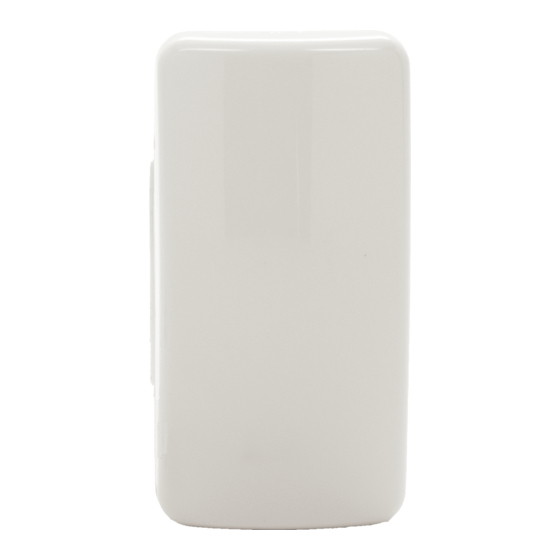
Honeywell ADEMCO 5821 Installation And Setup Manual
Temperature sensor & flood
detector
Hide thumbs
Also See for ADEMCO 5821:
- Installation and setup manual (4 pages) ,
- Installation instructions (4 pages) ,
- Installation instructions and owner's manual (2 pages)
Quick Links
GENERAL INFORMATION
The ADEMCO 5821 Temperature Sensor & Flood Detector is a
wireless transmitter used with Honeywell's ADEMCO alarm
systems that support 5800 series devices. The 5821 can be
configured to operate as a stand-alone temperature sensor
and/or as either a Remote Temperature Sensor or Flood
Detector. The 5821 in combination with the ADEMCO T280R
temperature probe is ideal for monitoring refrigerators and
freezers in restaurants, kitchens and warehouses where food
storage is a concern.
ADEMCO 470PB probe can be used to sense floods in
basements and other areas where there is a possibility of
flooding. The 5821 will send an alarm, via its RF transmitter, to
the control when the preset temperature limit is exceeded or
when a flood is detected. Temperature monitoring and flood
detection is dependent on the operating mode selected. Refer
to Table 1 for applicable operating modes.
Room temperature is monitored at the device using the 5821's
internal sensor.
Refrigerator or Freezer temperature is
monitored remotely using the ADEMCO T280R temperature
probe.
Flood detection is monitored remotely using the
ADEMCO 470PB probe with the supplied resistor. A separate
5821 is required for each external probe being used.
In refrigerator or freezer applications, when the temperature
increases past the high threshold limit and a delay of greater
than 30 minutes passes, an alarm is triggered. This preset
delay offers greater reliability against false alarms, especially
due to open refrigerator or freezer doors.
A 3-volt lithium battery powers the 5821. If the battery voltage
gets too low, the 5821 sends a low battery signal to the control
panel.
INSTALLING/REPLACING THE BATTERY
Important Notes:
•
Use 3-volt lithium battery:
Duracell DL 123A or Panasonic/Sanyo/Tekcell/Varta
CR123A.
•
Observe polarity.
•
When replacing the battery, wait at least 30 seconds after
removing the old battery, before installing the new one.
Install or replace the battery as follows:
1.
Remove the transmitter's top cover by inserting the flat
blade of a small screwdriver into the pry-off slot at one end
of the unit (see Figure 1 for location), and slightly twisting
the blade until the cover disengages.
2.
Install a 3-volt lithium battery as shown in Figure 1.
INSTALLATION AND SETUP GUIDE
The 5821 in combination with the
Temperature Sensor & Flood
TAMPER SUPERVISION
The 5821 tamper supervision feature (Loop 4) causes a trouble
signal to be sent to the control if the unit's cover is removed
from the base or if an external probe is used and the wire is cut
(open) or the probe is shorted.
used to program the unit's serial number and loop assignments
to the control panel.
SETTING THE OPERATING MODE
Table 1 provides a list of the various operating modes of the
5821 with the respective Loop and DIP Switch settings for
each.
Note that Cold Temp Sensing can be used in
combination with any of the other operating modes. To use the
transmitter to monitor two different conditions, you must
program each loop used on the 5821 as its own zone, and you
must set the DIP Switches as shown for the combination
functions in Table 1.
PROGRAMMING THE UNIT
Once you have selected an operating mode and have set the
DIP Switches accordingly, you must enroll the transmitter in
the control panel. When programming the transmitter in the
control panel, note that you must program a separate zone for
each loop you are using on the transmitter. To program:
1.
Enter the control's Zone Programming mode.
2.
Enter the zone number to be programmed.
3.
Enter the applicable zone type when prompted (zone
types such as 24-Hr. Aux, Waterflow, etc. should be used)
depending on the function of the zone and the control
panel being used (see the control panel's instructions for
available zone types and definitions).
4.
When prompted, enter Input Type 03 (3 on some controls)
– Supervised RF Transmitter.
5.
When prompted for the serial number, transmit from the
detector by pressing the tamper switch.
6.
When the serial number is displayed, transmit from the
detector again by pressing the tamper switch.
The current loop number (4) will begin to flash.
7.
Manually change the loop number to the desired loop
number for the zone (according to the application—see
Table 1).
8.
When programming for this zone is complete, program
other zones for the transmitter as necessary (each loop
requires its own zone.
9.
Exit Programming mode when programming is complete,
and test the detector. Refer to the Testing section.
K9947V2 10/05 Rev. A
ADEMCO 5821
Detector
The tamper switch is also

Summary of Contents for Honeywell ADEMCO 5821
- Page 1 TAMPER SUPERVISION The 5821 tamper supervision feature (Loop 4) causes a trouble The ADEMCO 5821 Temperature Sensor & Flood Detector is a signal to be sent to the control if the unit’s cover is removed wireless transmitter used with Honeywell’s ADEMCO alarm from the base or if an external probe is used and the wire is cut systems that support 5800 series devices.
- Page 2 MOUNTING THE DETECTOR To mount the detector, proceed as follows: Remove the battery. You can mount the 5821 on a wall or ceiling within the protection area. The following notes apply: Disengage the attached mounting plate from the case by •...
- Page 3 Table 1: 5821 Operating Mode Choices Switch External Faults when… Restores when… ✝ Operating Mode Setting Loop Probe SW1=OFF temperature drops below 45°F temperature rises 48°F (9°C) for No external Cold Temp Sensing >4 minutes. probe (7°C) for >10 minutes. SW2=OFF SW1=OFF temperature rises above 95°F...
- Page 4 This feature prevents false alarms due to open doors and other transitory conditions. 165 Eileen Way, Syosset, New York 11791 Copyright © 2004 Honeywell International Inc. www.honeywell.com/security ÊK9947V2}Š K9947V2 10/05 Rev. A...















